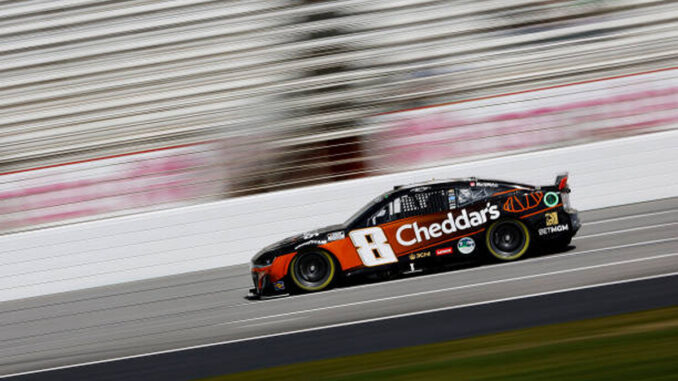
At most NASCAR race tracks, speeding on pit road draws a penalty that can be overcome with speed or ingenuity.
At Atlanta Motor Speedway, however, speeding under a green flag can be the equivalent to a death penalty, as far as a driver’s chances of winning the race are concerned.
The approach to a driver’s pit stall at Atlanta involves two distinct sections, 1) an access road through Turns 3 and 4, constituting pit road sections 1 and 2, with a 90-mph speed limit under green, and 2) pit road sections 3 through 18, from the yellow entrance line to the yellow exit line.
The speed limit in Sections 3 through 18 is 45 mph. Under caution the 45-mph limit applies to all sections.
Because of the long approach, speeding under green-flag conditions will cost a driver two laps and likely ruin the race.
But the process of maintaining pit road speed adds a layer of complication. Since the NASCAR Cup Series cars don’t have speedometers, typically that means more warning lights and/or additional pages on the digital dashboard.
“You’re not getting down to 45 mph… you’re getting down to 90 mph, so the gearing is a lot different,” said DAYTONA 500 champion William Byron, who has won two of the last four Atlanta races. “The lights are built way differently. I think we chose to go with third gear this time (in the 90-mph section). Last time, we were in fourth.
“So, I feel like just trying to understand the cadence there. My engineers sent me a bunch of stuff, some layouts to make sure I’m aware of what lights I need to run. But the biggest thing is don’t speed, because under green, that section is not that important in comparison to being a couple of laps down here. If you go a couple of laps down with how long that pit road is now, your race is ruined. So, you just have to not speed.”
Though drivers enter pit road at Turn 3, the process starts at the exit of Turn 2.
“The 90-mile-an-hour pit road speed is almost twice as fast as anywhere that we have,” said Christopher Bell. “So, we’re racing in fifth (gear). It’ll be a third-gear pit road speed whenever you hit the line, and you have to be mindful of not speeding, because if you speed, you’re going to lose multiple laps.
“So, it’s third-gear pit road, and then there will be another downshift when you approach Turn 4 to get down to 45. It’s very unique and very tricky and not one you want to play games with, for sure.”
Kyle Busch is one of the most accomplished drivers at getting on and off pit road. At Atlanta, there are a lot more variables than usual.
“We’ll likely have two pages (on the dashboard) – one for under green and one for under yellow that we’ll use for different lights and what we’ll look for in the gearing, RPM ranges and whatnot,” Busch said. “If you’re under green and you’re coming off of Turn 2, you have to make sure you’re on page two – whatever page it is – and then you’ll slow down as quickly as you can, as late as you can, in order to make it to the 90-mph speed zone by the first line.
“Carry that around the corner and then you’ll slow down through your lights and then run your pit road lights. There are different colors (of lights) – you’ve got three different sets of colors that you can go through, so there’s a pretty wide range. You’ll probably run all reds… actually you’ll run probably four blues through the corner, and then you’ll run all reds on pit road. That’s typically what we do.”
- Ryan Blaney has ‘no fun’ at Indy - July 21, 2024
- Tyler Reddick grabs pole for return to Indianapolis oval - July 20, 2024
- For Hoosier Chase Briscoe a win on the Indy oval would mean everything - July 20, 2024